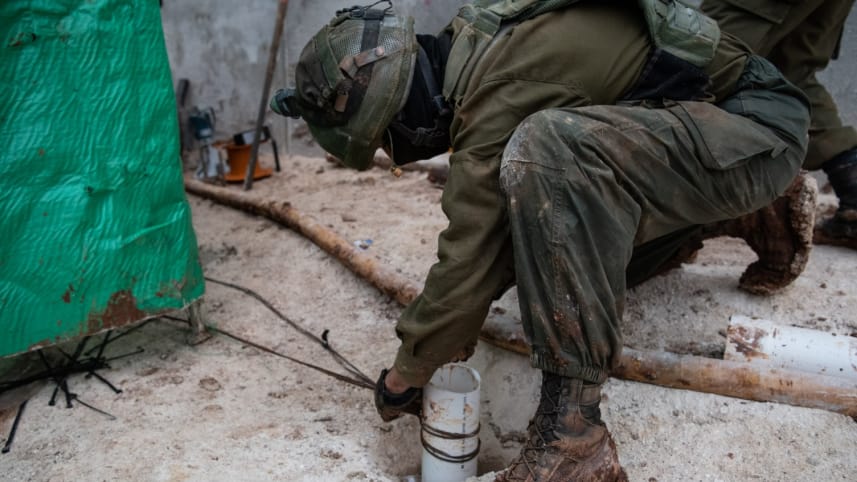Analysis/Israeli Operation Against Hezbollah Tunnels Enters Its Explosive Stage
عاموس هاريل من الهآررتس: العملية الإسرائيلية ضد انفاق حزب الله تدخل مرحلتها المفجرة
Amos Harel/Haaretz/December 11/18
There is no wall or fence separating the Israeli and Lebanese forces where the demolition is going on. All it would take is one antsy Lebanese soldier to spark a fire that would be hard to extinguish
The army’s activity on the Lebanese border, which was initially described with some disparagement as a defensive engineering operation of negligible importance, is now reaching a more sensitive stage. After several days of confusion, it is clear that the Lebanese government has begun to formulate a response to the Israeli move.
Lebanese army patrols are now facing Israeli forces in those areas where Israel Defense Forces soldiers are digging near the border. In particular, the tension is rising – and with it the potential for a mistake that could develop into a confrontation – in those “enclaves” where the IDF is operating. These are areas north of the border fence over which Israel claims sovereignty according to a UN decision.
In these areas there is no wall or fence separating the Israeli and Lebanese forces. In some places, the IDF has stretched barbed wire to mark the exact location of the border. But the images being published on the Lebanese side, for example, from the village of Meiss al-Jabel, tell the main story of the last few days; you can see Israeli soldiers in them, equipped with rifles and anti-tank missiles, while an Israeli bulldozer is working on the other side of the rock.
In these areas there is no wall or fence separating the Israeli and Lebanese forces. In some places, the IDF has stretched barbed wire to mark the exact location of the border. But the images being published on the Lebanese side, for example, from the village of Meiss al-Jabel, tell the main story of the last few days; you can see Israeli soldiers in them, equipped with rifles and anti-tank missiles, while an Israeli bulldozer is working on the other side of the rock.
When both sides are viewing each other from relatively close range, each equipped with weapons aimed at the other side of the border, as UNIFIL soldiers try to serve as a buffer between the Israelis and the Lebanese (with Hezbollah members presumably watching closely), it’s a recipe for a possible eruption. The IDF will have to manage the work with extreme precision and caution so as not to spark an unwanted incident. Everyone’s nerves are tense enough; all it would take is one antsy Lebanese soldier to spark a fire that will be hard to extinguish.
A brief reminder: Israel withdrew in May 2000 from southern Lebanon and regrouped on the Blue Line, the international border recognized by the United Nations and drawn by its experts. But in some places along the border, the fence, for engineering reasons, was built south of the Blue Line, leaving enclaves under Israeli sovereignty north of it.’
After the Second Lebanon War in 2006, Israel insisted on maintaining a military presence in these enclaves by making periodic patrols. The Lebanese government recognizes the UN map in principle but holds reservations about 13 points along the border. The dispute between the two sides has intensified over the past year because Israel has begun to build a wall to prevent land infiltrations in two of these disputed areas, between Kibbutz Manara and Misgav Av, and east of Rosh Hanikra.
There have been several incidents connected to Israeli activity in the enclaves. In 2007 there was an exchange of fire between an IDF force and a Lebanese army armored personnel carrier, when Israel insisted on establishing facts on the ground in one of the enclaves. In 2010 a reserve battalion commander, Lt. Col. Dov Harari, was killed by Lebanese soldiers when the IDF trimmed trees in an enclave near Kibbutz Manara.
The Israeli operation to locate the tunnels is making everyone involved tense. All the players on the Lebanese side have something to hide. Hezbollah dug the tunnels, violating the cease-fire agreements; the Lebanese army, which receives extensive assistance from the United States and France, did not lift a finger to prevent Hezbollah’s activities (and its intelligence personnel sometimes actually help Hezbollah); and UNIFIL was mainly busy staying out of trouble.
The tunnels being exposed have their origins in homes in Lebanese villages; Israel for years asked the UN to survey these sites but was rebuffed on the grounds that these are private courtyards and UNIFIL would need solid evidence in order to check them. To Israeli eyes, this all looks like a cover-up in which the Lebanese government and the United Nations are taking an active role, even if they did not have detailed intelligence about Hezbollah’s secret excavations. Along with Israel’s goal of denying Hezbollah these assets and to leverage the discovery in the diplomatic arena, seeds have been planted that are leading to a long-expected serious crisis of confidence between Israel and the United Nations.
All this is taking place on the backdrop of the thunderous, prolonged silence of Hezbollah, which has not yet responded to Israel’s declarations. One could assume that the organization is preoccupied with finding out how its secrets fell into IDF hands and what exactly Israeli intelligence knows about the rest of its plans. If there is a direct confrontation along the border, it is more likely to take place between the IDF and the Lebanese army, as it has in the past. But in the longer term, locating and destroying the tunnels will require Hezbollah and its Iranian patrons to reexamine the deployment along the Israeli border.





















